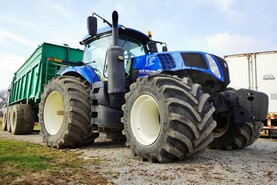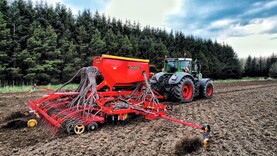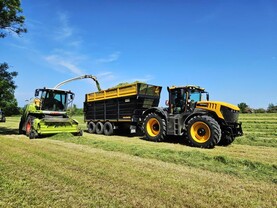With the wettest July on record now behind us, ground conditions continue to deteriorate in many parts of the country.
July recorded more than four times the amount of rain observed in July 2022 and more than twice that in 2021. Most of Ireland’s tillage areas have received over 100mm of rain more this July in comparison to the same period last year. Taking Oak Park, Co Carlow, for example, it received 144mm of rain last month compared with 25.4mm and 61.8mm for the period over the past two consecutive years, according to Met Éireann.
To date, it’s been very much a snatch-and-grab harvest and second-cut silage season, going when the weather allows between showers.
While dry spells may leave crops fit for threshing, trafficability can still pose a threat.
In this situation, increased levels of soil compaction and surface damage are likely to occur.
With that in mind, there are a number of things we can do to minimise the impact of such challenges. Below, we look at four key areas worth considering in order to help reduce soil compaction.
While this article focuses mainly on machinery associated with the grain harvest, a lot of the information is directly relatable to silage-making and other land operations.
Inflation pressures
Ensure inflation pressures are correct and as low as possible for the axle loading, regardless of machine in question. The combine’s axles should be weighed with the header fitted to establish accurate weights.
An exact tyre pressure can then be determined from a tyre manual, taking into account that the axle will only be fully loaded at low speeds (<10 km/h). Lower speeds allow lower pressures and provide better flotation.
Even when running a modern combine, don’t assume the desired inflation pressures are being achieved out of the box.
Again, determine the target pressures, measure axle loading and establish whether your tyres can achieve the result desired for the given load and operating speed.
It is important to note that pressures may need changed for road transport purposes as axle loading and forward speed will have changed.
Check tractor and grain trailer tyre pressures too and make reductions, if possible, using the same approach.
Tyre sizes and tech
Bear in mind, larger tyres have the potential to work at lower inflation pressures and therefore exert lower ground pressure. It is recommended to have a tyre large enough to operate at 1.0 bar or less in wet conditions. Whereas in dry conditions, tyres large enough to work at 1.5 bar would be sufficient.
Before fitting larger diameter or wider tyres, consider limitations and 4WD ratio. If a combine’s front wheels are being changed, consider upgrading the rear wheels to improve their flotation and in order to keep the combine level, if larger diameter tyres are being fitted at the front.
The use of modern tyre technology, primarily increased flexion (IF) and very high flexion (VHF) will allow for lower ground pressures. This technology allows more side wall deflection and therefore reduced inflation pressures, as a result.
For example, compared to standard tyres, IF tyres can carry approximately 20% more weight and VF tyres can carry 40% more at the same inflation pressure.
Alternatively, this can be interpreted as 17% (IF) and 30% (VF) less inflation pressures for the same given load as a standard tyre. Although pricing for such technology continues to become more competitive, it still commands a premium over standard tyres.
While changing tyres have benefits in terms of ground pressure, there can be some negatives. Firstly, there is a significant cost involved in upgrading tyres, especially to IF and VF technologies and or if rims also need changing.
Secondly, wider tyres can cause complications when it comes to transport. Thirdly, tyres exerting lower ground pressure can offer lower levels of traction, especially on slopes or hills, as lugs cannot penetrate the surface.
Dual wheels can be a more cost-effective way of reducing ground pressure. However, they can place additional strain on the combine’s axle and may invalidate warranty on fresher machines.
While dimensions can vary, the overall diameter will need to be the same and the correct fitment mechanisms will need to be used.
Although not easily retrofitable, rubber tracks can help reduce ground pressure while retaining a relatively narrow overall track width. However, this is only the case if tracks provide a long contact patch and achieve less than one bar of ground pressure. While tracks prove a considerable cost new, a tyre combination capable of achieving similar ground pressures often will not come in much cheaper.
Tractors and grain trailers
Tractor and trailer tyres should be correctly and evenly inflated. If IF or VF tyres are fitted, then use them to the best of their ability.
Consider upgrading the primary grain trailer tyres to a larger size or IF or VF technology, as it will likely be justified.
This is where chaser bins have an advantage as they serve as a dedicated field trailer and avoid having to fit low ground pressure tyres to a number of trailers.
Trailers with super-single tyres should be avoided at all costs. They can cause untold harm in terms of soil compaction as they have not been designed for low ground pressures.
However, there are a number of things that can be done to improve ground trafficability at little cost when it comes to tractors and trailers.
Start by limiting trailer wheel traffic in the field even though it may prove slightly less efficient time wise. Fill grain trailers static to reduce traffic or only fill to between 50% and 70% on the move and fill the remainder static on the headland.
If filling on the go, offload the combine quickly and stop the tractor and move directly to where the combine will unload next time.
It may not prove possible to establish less than 1.0-bar pressure, but if an improvement of some kind ie reducing pressures from 2.5-bar to 1.5-bar can be made, then it proves a good starting point.
Driver technique
Encourage drivers to think logically, drive smoothly and with sympathy for the soil. Planning in relation to movements for loading and exiting the field can prove hugely beneficial. For example, only stop the tractor where you know it will be easy to start again.
Similarly, take care not to tear the surface of the soil when accelerating with loads from rest.






 This is a subscriber-only article
This is a subscriber-only article










SHARING OPTIONS: